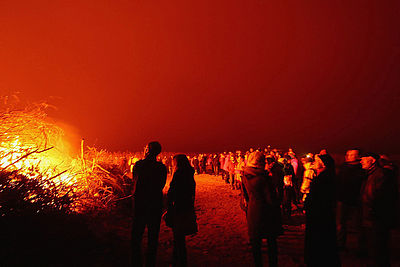
Culture at the North Sea
Art, culture and culinary delights? That we can. And even in five languages: High and Low German, High and Low Danish and Frisian. Welcome to Germany’s northernmost cultural site!
On the evening of 21 February, fire burns on the islands and Halligen of the North Sea coast. It lights up the darkest of nights. The Frisian carnival custom, which is mentioned in the books of regional history as early as 1740, is supposed to drive away the spirits of winter and welcome the new harvest year. Shortly before the start of Lent, there are, of course, plenty of hot, high-proof drinks at the Frisian national festival. A glass of “Pharisäer” or “Tote Tante”, for example, is far tastier than you could imagine: Coffee or cocoa with at least three centilitres of rum and cream topping will be sure to warm you from the inside.

Typical regional specialities such as kale with caramelised potatoes or the Schleswig-Holstein national dish of pears, beans and bacon are equally popular accompaniments to the festivities. North Friesland is indeed the district in Schleswig-Holstein that, apart from its lively historical customs, also has the highest density of museums in the country. Theodor Storm from Husum and Nobel Prize winner for literature and namesake Theodor Mommsen are looked upon with pride. The Seebüll Ada and Emil Nolde Foundation in Seebüll, as well as the Museum Kunst der Westküste on Föhr, attract thousands of art fans every year. On the Eiderstedt peninsula, there is a picturesque little church in almost every village, from Garding and Tating, to Tönning and Tetenbüll, which invites you to pause and find peace.
